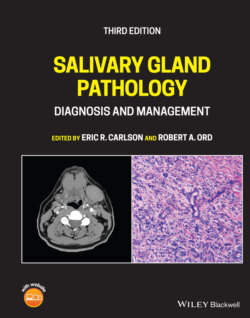Читать книгу Salivary Gland Pathology - Группа авторов - Страница 60
MAGNETIC RESONANCE IMAGING (MRI)
ОглавлениеMagnetic resonance imaging (MRI) represents imaging technology with great promise in characterizing salivary gland pathology. The higher tissue contrast of MRI, when compared to CT, enables subtle differences in soft tissues to be demonstrated. Gadolinium contrast‐enhanced MRI further accentuates the soft‐tissue contrast. Subtle pathologic states such as perineural spread of disease are better delineated when compared with CT. This along with excellent resolution and exquisite details make MRI a very powerful technique in head and neck imaging, particularly at the skull base. This notwithstanding, its susceptibility to motion artifacts and long imaging time as well as contraindication due to claustrophobia, pacemakers, aneurysm clips, deep brain and vagal nerve stimulators limit its usefulness in the general population as a routine initial diagnostic and follow‐up imaging modality. Many of the safety considerations are well defined and detailed on the popular website, www.mrisafety.com.
